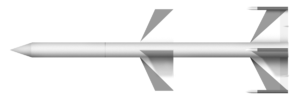K-9 (missile)
Short-range air-to-air missile From Wikipedia, the free encyclopedia
The K-9 (NATO reporting name AA-4 'Awl') was a short-range air-to-air missile developed by the Soviet Union in the late 1950s. It was designed by MKB Raduga, a division of aircraft maker Mikoyan-Gurevich. The K-9 was also known as the K-155, and would apparently have had the service designation R-38. It was intended to arm the Mikoyan-Gurevich Ye-152A (NATO reporting name 'Flipper'), an experimental high speed twin-engine aircraft, predecessor to the Mikoyan-Gurevich MiG-25 'Foxbat'. When the Ye-152A was shown at Tushino in 1961, a prototype of the K-9 missile was displayed with it.[1]
| K-9 | |
|---|---|
 K-9 prototype missile | |
| Type | short-range air-to-air missile |
| Place of origin | Soviet Union |
| Production history | |
| Manufacturer | Raduga |
| Specifications | |
| Mass | 245 kg (540 lb) |
| Length | 4.5 m (14 ft 9 in) |
| Diameter | 250 mm (9.8 in) |
| Wingspan | 1.6 m (5 ft 3 in) |
| Warhead | 27 kg (60 lb) |
| Engine | two-stage solid-fuel rocket engine |
Operational range | 9 km (5.6 mi) |
| Maximum speed | 5,040 km/h (3,130 mph) |
Guidance system | SARH |
Launch platform | Mikoyan-Gurevich Ye-152A |
Neither the 'Flipper' nor the 'Awl' ever entered production.[2]
Notes
References
Wikiwand - on
Seamless Wikipedia browsing. On steroids.
